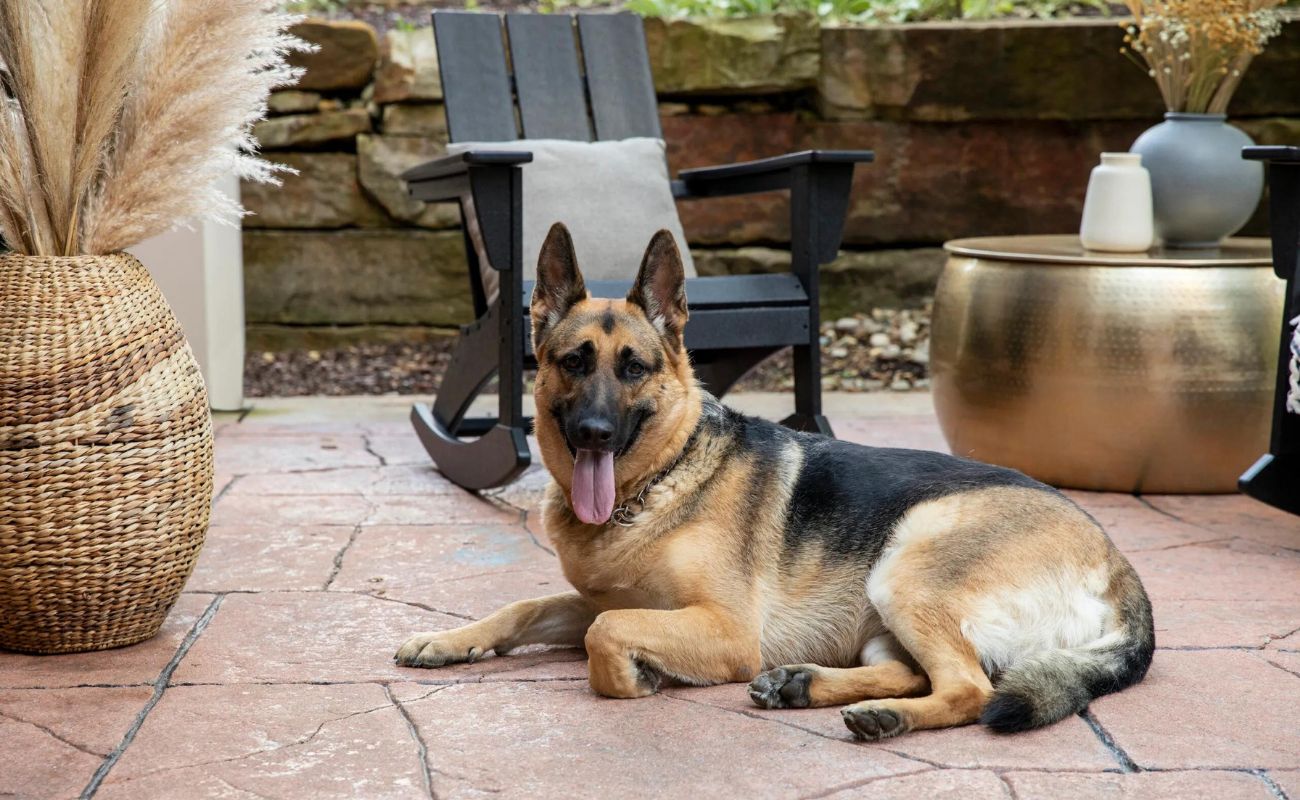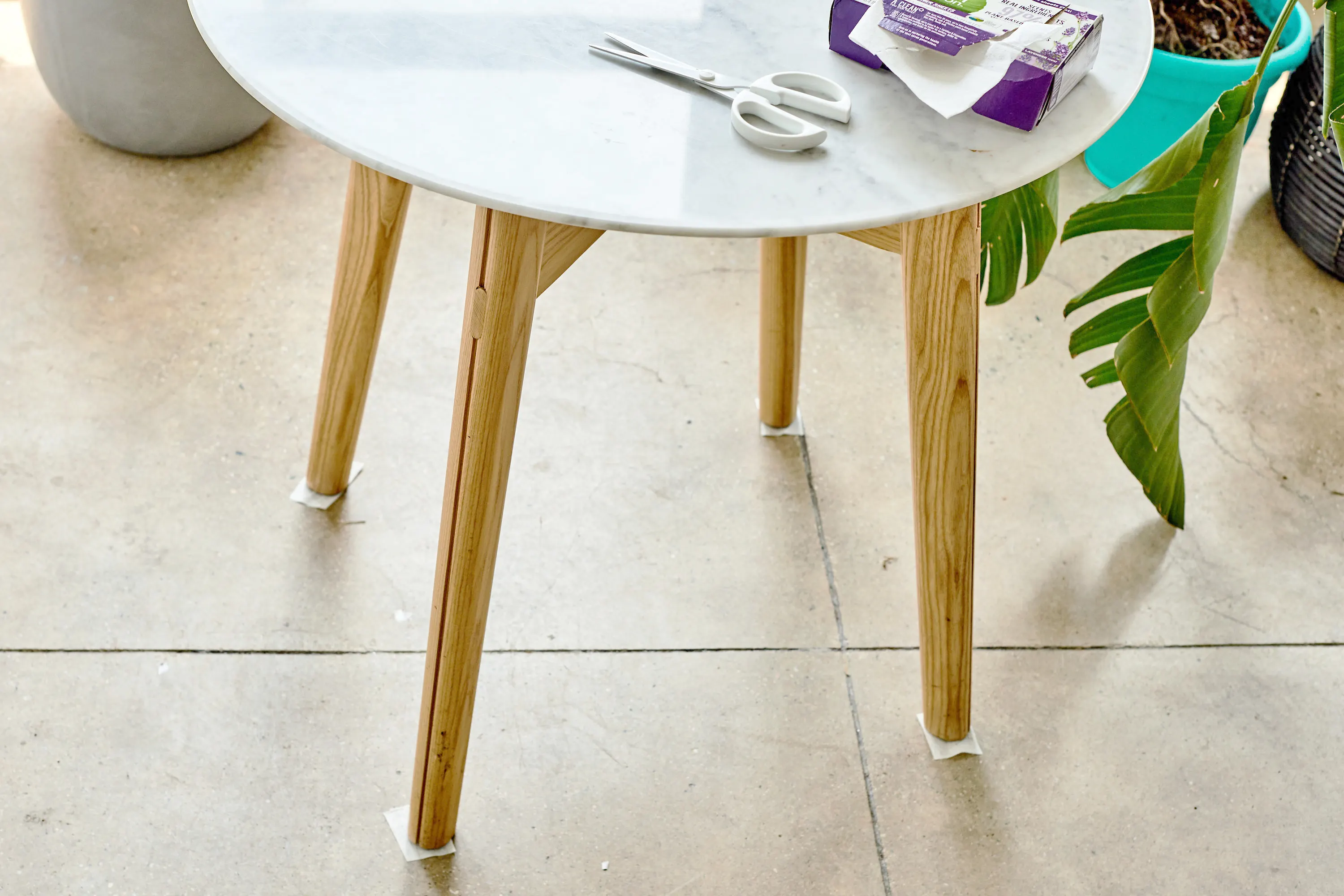Home>Furniture>Outdoor Furniture>How To Keep Dogs Off Patio Furniture


Outdoor Furniture
How To Keep Dogs Off Patio Furniture
Modified: March 25, 2024
Looking for ways to keep your outdoor furniture safe from your furry friends? Find out how to keep dogs off patio furniture with these helpful tips.
(Many of the links in this article redirect to a specific reviewed product. Your purchase of these products through affiliate links helps to generate commission for Storables.com, at no extra cost. Learn more)
Introduction
Outdoor patio furniture provides a comfortable and inviting space for relaxation and enjoyment. However, if you are a dog owner, you may have encountered the frustrating challenge of trying to keep your furry friend off the furniture. Dogs are naturally curious and social creatures, and they can be irresistibly attracted to the cozy cushions and enticing scents of your outdoor seating. So, how can you keep dogs off your patio furniture while still ensuring their comfort and happiness?
In this article, we will explore effective strategies and solutions to help you address this common issue. Whether you have a mischievous puppy or a seasoned pooch, understanding why dogs are drawn to patio furniture and implementing preventive measures will promote a harmonious coexistence between your furry friend and your outdoor living space.
Key Takeaways:
- Designate a cozy spot for your dog with a bed, toys, and shade to keep them off patio furniture and create a harmonious outdoor space.
- Use repellents, training, and alternative furniture options to redirect your dog’s attention and maintain boundaries in your outdoor living area.
Read more: How To Keep Spiders Off Patio Furniture
Understanding why dogs are attracted to patio furniture
Before diving into solutions for keeping dogs off patio furniture, it is important to understand why our furry friends are so irresistibly drawn to it. Dogs are naturally curious creatures, and patio furniture provides an array of intriguing scents, textures, and comfortable spots for them to explore and claim as their own.
Dogs are territorial animals, and they often seek out objects that have a strong scent of their owners or other familiar individuals. The cushions and upholstery of patio furniture may carry the scent of their favorite humans, making it a desirable place to rest or mark as their territory. Additionally, any lingering food crumbs or remnants can also be quite tempting for a hungry pup.
Furthermore, dogs may see patio furniture as an elevated vantage point. From there, they can observe their surroundings and keep an eye on their human companions. This elevated position satisfies their natural instinct to be on the lookout for potential threats or prey.
Another reason dogs are attracted to patio furniture is that they often seek out soft, comfortable surfaces. The cushions and upholstery provide a cozy and supportive spot for them to rest and relax. Just like humans, dogs appreciate the plushness and comfort that these furniture pieces offer.
Understanding why dogs are drawn to patio furniture is the first step in effectively addressing this issue. By recognizing their natural instincts and desires, we can implement strategies to create a more inviting and appropriate space for our furry friends.
Creating a designated space for your dog
One of the most effective ways to keep dogs off patio furniture is to provide them with a designated space of their own. By creating a comfortable and inviting area specifically for your four-legged friend, you can redirect their attention away from your furniture.
Start by selecting a suitable location for your dog’s space. This can be a corner of your patio or a specific area in your yard. Choose an area that is easily accessible and has enough room for your dog to move around comfortably.
Next, invest in a dog bed or a comfortable outdoor pet mat. Look for a bed that is durable, weather-resistant, and easy to clean. Place the bed in your dog’s designated area, making it a more appealing option than the patio furniture.
To make the space more enticing, consider adding some of your dog’s favorite toys or chew treats. This will create a positive association with their designated area and help distract them from the furniture.
In addition to providing a comfortable space, it is essential to provide shade and protection from the elements. Dogs can easily overheat in the sun, so ensure that their designated area has a shady spot or use a dog canopy to provide shelter.
Remember to regularly clean and freshen up your dog’s space to keep it appealing and inviting. This will reinforce the idea that their designated area is a desirable place to relax and enjoy.
Creating a designated space for your dog not only gives them a sense of ownership but also helps to divert their attention away from the patio furniture. By offering a comfortable and attractive alternative, you can significantly reduce their desire to climb onto your outdoor seating.
Using repellents and deterrents
If creating a designated space for your dog doesn’t seem to be effective in keeping them off the patio furniture, there are various repellents and deterrents that you can utilize to discourage their unwanted behavior.
One option is to use a pet-safe deterrent spray. These sprays are typically formulated with natural ingredients that emit scents that dogs find unpleasant. Simply spray the deterrent on the patio furniture, focusing on the areas where your dog tends to climb or rest. The unpleasant scent will discourage them from approaching or staying on the furniture.
Alternatively, you can make your own DIY deterrent spray using ingredients like vinegar, citrus, or pepper. Dogs generally dislike the scent of these substances, and spraying them on the furniture can be an effective deterrent.
Another option is to use physical barriers or covers to prevent your dog from accessing the patio furniture. For example, you can place baby gates or barriers around the furniture to create a physical barrier that your dog cannot pass through. This strategy works well for small or medium-sized dogs.
If your dog is a determined climber, you can try covering the furniture with plastic tarps or fitted covers. These covers restrict access to the cushions and upholstery, making them less appealing to your dog.
For a more high-tech solution, consider using ultrasonic devices or motion-activated sprinklers. These devices emit high-frequency sounds or bursts of water when they detect motion, startling your dog and dissuading them from approaching the furniture. These devices are safe for both pets and humans.
Remember to be consistent with the use of repellents and deterrents. It may take some time for your dog to associate the unpleasant experiences or scents with the patio furniture. Patience and persistence are key in effectively using these tools to keep your dog off the furniture.
While repellents and deterrents can be effective in discouraging dogs from climbing onto patio furniture, it is important to accompany these strategies with positive reinforcement and training to ensure long-term success.
To keep dogs off patio furniture, try using a pet deterrent spray with natural ingredients like citrus or bitter apple. Apply it to the furniture regularly to discourage them from jumping up.
Training your dog to stay off the furniture
Training your dog to stay off the patio furniture requires consistency, patience, and positive reinforcement. With proper training, you can teach your furry friend to respect the boundaries and understand that the furniture is off-limits.
Start by establishing clear rules and boundaries. Decide whether you want your dog completely off the furniture or if there are specific pieces they are allowed on. Consistency is key, so make sure that all family members enforce the same rules.
Use positive reinforcement to reward your dog for staying off the furniture. Whenever you notice them avoiding the furniture, offer praise, treats, or a favorite toy. This will reinforce the desired behavior and motivate them to continue staying off the furniture.
Redirect your dog’s attention to their designated area whenever they attempt to climb onto the furniture. Encourage them to go to their bed or mat and reward them for choosing their own space.
Consistently reinforce the command “off” or “down” whenever your dog is on the furniture. Be firm but gentle in your tone and guide them off the furniture if necessary. Reward them for complying with the command to reinforce the desired behavior.
If your dog consistently ignores the command to stay off the furniture, consider using a training aid such as a pet-safe boundary mat or a pet-proof tape. Place the boundary mat or tape on the furniture to create a visual and physical deterrent.
If your dog has difficulty understanding the concept of staying off the furniture, you may also consider using positive punishment techniques such as a harmless deterrent noise like a whistle or a shake can. These methods should only be used in conjunction with positive reinforcement and should never involve physical punishment.
Stay patient and consistent with the training process. It may take time for your dog to understand and consistently follow the rules. Keep reinforcing the positive behavior and redirecting them to their designated area. With patience and persistence, your dog will learn to stay off the furniture.
Read more: How To Keep Squirrels Off Patio Furniture
Providing alternative furniture options for your dog
One effective strategy to deter your dog from climbing onto the patio furniture is to provide them with their own comfortable and inviting furniture alternatives. By offering options that are specifically designed for their needs, you can redirect their attention away from your furniture.
Investing in a dog-specific outdoor bed or mat is a great start. Look for a bed that is made from durable, weather-resistant materials and is easy to clean. Place the bed in a shaded area of your patio or yard, creating a cozy spot for your dog to relax and enjoy the outdoors.
Consider adding a dog-friendly hammock or cot to your outdoor space. These elevated sleeping options provide a comfortable and cool spot for your dog to rest, while also giving them a sense of elevation and security.
If your dog prefers a more enclosed space, you can provide a doghouse or a sheltered area with a cozy blanket or cushion. This will give them a den-like environment where they can feel safe and secure.
In addition to providing alternative furniture options, remember to make these spaces appealing to your dog. Add their favorite toys, chew treats, or interactive puzzles to keep them engaged and entertained. This will further incentivize them to choose their own furniture over yours.
Regularly clean and refresh your dog’s furniture alternatives to maintain their appeal. Remove any dirt or debris and wash any removable covers or cushions. A clean and inviting space will encourage your dog to choose their own furniture over yours.
By offering alternative furniture options designed specifically for your dog, you are providing them with comfortable and inviting spaces that meet their needs. This not only helps deter them from climbing onto your patio furniture but also ensures that they have their own designated spots to relax and enjoy the outdoors.
Practicing consistent reinforcement and discipline
Consistency is key when it comes to keeping dogs off patio furniture. By practicing consistent reinforcement and discipline, you can effectively communicate your expectations to your furry friend and maintain boundaries in your outdoor space.
First and foremost, establish clear rules and guidelines regarding furniture use. Decide whether your dog is allowed on any furniture or if there are specific pieces they can access. Make sure all family members are aware of and enforce these rules consistently.
When you catch your dog attempting to climb onto the furniture, use a firm and assertive voice to give a command such as “off” or “down”. Ensure that your tone is clear and authoritative without being harsh or aggressive. Follow through with guidance or redirection if needed.
Avoid physically punishing your dog for getting on the furniture, as this can create fear or anxiety. Instead, focus on positive reinforcement. When your dog chooses to stay off the furniture or follows your command to get down, praise and reward them with treats, verbal affirmation, or playtime.
Consistency is essential in reinforcing the desired behavior. Be diligent in consistently enforcing the rules and rewarding your dog for compliance. If you are inconsistent with expectations, it can confuse your dog and make it difficult for them to understand what is allowed and what is not.
In addition to consistent reinforcement, provide your dog with plenty of physical and mental stimulation. Dogs often resort to climbing on furniture out of boredom or pent-up energy. Regular exercise, interactive playtime, and brain-training activities will help keep them mentally and physically satisfied, reducing their inclination to seek entertainment on the patio furniture.
Be patient and understanding during the training process. It may take time for your dog to understand and consistently follow the rules. Celebrate progress and recognize their efforts, even if they occasionally slip up. With time, consistency, and positive reinforcement, your dog will learn to respect the boundaries and stay off the patio furniture.
Conclusion
Keeping dogs off patio furniture can be a challenge, but with the right strategies and consistent effort, it is entirely achievable. By understanding why dogs are attracted to patio furniture and implementing practical solutions, you can promote a harmonious coexistence between your furry friend and your outdoor living space.
Creating a designated space for your dog, complete with a comfortable bed or mat, toys, and shade, gives them a designated area of their own. This helps redirect their attention away from the patio furniture and provides a cozy spot for them to relax.
Using repellents and deterrents, such as pet-safe sprays, physical barriers, or high-tech devices, can effectively dissuade your dog from venturing onto the furniture. These tools provide a clear signal that the furniture is off-limits and redirect their focus to their designated area.
Training plays a crucial role in teaching your dog to stay off the furniture. With consistency, positive reinforcement, and clear boundaries, you can communicate your expectations and redirect their behavior. Training also ensures a positive and trusting relationship between you and your furry companion.
Providing alternative furniture options specifically designed for your dog, such as outdoor beds, hammocks, or doghouses, gives them their own comfortable spaces to enjoy. By making these alternatives appealing and engaging, you can entice your dog to choose their own furniture over yours.
Lastly, practicing consistent reinforcement and discipline is essential for maintaining boundaries and communicating your expectations to your dog. By rewarding the desired behavior and redirecting them when needed, you can enforce the rules effectively and encourage them to stay off the furniture.
Remember, patience and perseverance are key. It may take time for your dog to adjust and understand the boundaries, but with consistency, positive reinforcement, and proper training, you can create a peaceful and enjoyable outdoor space for both you and your furry friend.
So, take the necessary steps to keep your dog off the patio furniture, and enjoy the outdoor environment together without any unwanted surprises or compromises.
Frequently Asked Questions about How To Keep Dogs Off Patio Furniture
Was this page helpful?
At Storables.com, we guarantee accurate and reliable information. Our content, validated by Expert Board Contributors, is crafted following stringent Editorial Policies. We're committed to providing you with well-researched, expert-backed insights for all your informational needs.















0 thoughts on “How To Keep Dogs Off Patio Furniture”